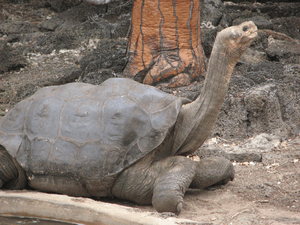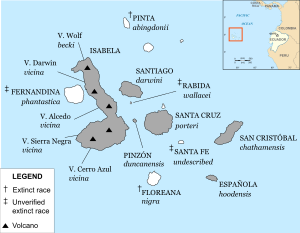Pinta Island tortoise facts for kids
Quick facts for kids Pinta Island tortoise |
|
|---|---|
 |
|
| Lonesome George at the Charles Darwin Research Station in 2006, the last known individual of his species of Galápagos tortoise | |
| Conservation status | |
| Scientific classification |
|
| Kingdom: | Animalia |
| Phylum: | Chordata |
| Class: | Reptilia |
| Order: | Testudines |
| Suborder: | Cryptodira |
| Family: | Testudinidae |
| Genus: | Chelonoidis |
| Species: | |
| Subspecies: |
†C. n. abingdonii
|
| Trinomial name | |
| Chelonoidis niger abingdonii (Günther, 1877)
|
|
 |
|
| Map of the Galápagos Islands indicating species' locations | |
| Synonyms | |
|
|
The Pinta Island tortoise (Chelonoidis niger abingdonii) was a type of giant tortoise that lived only on Pinta Island in the Galápagos Islands, Ecuador. It is also known as the Pinta giant tortoise or Abingdon Island tortoise.
Scientists first described this tortoise in 1877. Sadly, by the late 1800s, most Pinta Island tortoises were gone because people hunted them. For a long time, everyone thought they were completely extinct.
Then, in 1971, a single male tortoise was found on Pinta Island. He was named Lonesome George. Scientists tried to help George have babies with other types of tortoises, but it didn't work.
Lonesome George died in 2012, and many believed the Pinta Island tortoise was then completely extinct. However, later that year, researchers found 17 young tortoises on Isabela Island that were part Pinta Island tortoise. This means their parents, or even pure Pinta tortoises, might still be alive! The Pinta Island tortoise is officially listed as extinct by the IUCN.
Contents
About the Pinta Island Tortoise
Lonesome George and the other tortoises from Pinta Island belonged to a group of 15 different types of giant tortoises. Giant tortoises used to live on almost every continent except Australia and Antarctica. The Galápagos tortoises are the largest living tortoises in the world today.
The Pinta Island tortoise was first described in 1877 by a scientist named Albert Günther. He named it Testudo abingdonii. The name abingdonii comes from Abingdon Island, which is now called Pinta Island.
Evolution of Galápagos Tortoises
Scientists are still trying to figure out exactly how Galápagos tortoises evolved and are related to other tortoises. Even Charles Darwin was fascinated by them! DNA studies suggest that the closest living relatives of Galápagos tortoises are found in South America. These include the yellow-footed tortoise, the red-footed tortoise, and the Chaco tortoise.
Life and Habits
Galápagos tortoises, including the Pinta Island type, usually rested for about 16 hours a day in the wild. They were herbivores, meaning they ate plants. Their diet included greens, grasses, native fruits, and cactus pads. They could drink a lot of water and store it in their bodies, allowing them to survive for up to six months without food or water.
Reproduction and Life Cycle
Tortoises were most active for breeding during the hot season, from January to May. During the cooler season, from June to November, female tortoises would travel to special nesting areas to lay their eggs.
Giant tortoises are very important to the Galápagos ecosystem. They help spread seeds and change the island environment by eating plants and recycling nutrients. The extinction of the Pinta Island tortoise has affected how the island's ecosystem works.
Relationship with Humans
Threats and Conservation Efforts
Many of the remaining types of Galápagos tortoises are in danger. Their numbers started to drop in the 1600s when buccaneers (pirates) and whalers visited the islands. These visitors hunted tortoises for fresh meat, taking about 200,000 tortoises in total.
In 1958, goats were brought to Pinta Island. They ate most of the plants, which harmed the tortoises' natural home. A long effort began to remove the goats from the island. As the number of goats went down, the plants started to grow back. Small trees, shrubs, cactus, and other native plants increased. In 2003, Pinta Island was declared free of goats.
Besides removing goats, there have been efforts to help other types of Galápagos tortoises by breeding them in captivity. Future plans might try to create a tortoise population similar to the original Pinta Island tortoise. This could be done by breeding the young hybrid tortoises found on Wolf Volcano.
Lonesome George
The last known Pinta Island tortoise was a male named Lonesome George. He died on June 24, 2012. In his final years, he was known as the rarest creature in the world. George became a powerful symbol for conservation efforts in the Galápagos and around the globe.
George was first seen on Pinta Island on December 1, 1971. For his safety, he was moved to the Charles Darwin Research Station on Santa Cruz Island. There, he lived with two female tortoises of different types. Even though the females laid eggs, none of them hatched. This meant the Pinta tortoise was considered "functionally extinct."
Over many years, all attempts to help Lonesome George mate were unsuccessful. This might have been because his type of tortoise could not have babies with the other types. On June 24, 2012, Lonesome George was found dead by his caretaker of 40 years, Fausto Llerena. Scientists believe he died of heart failure, which is common at the end of a tortoise's natural life.
Possible Remaining Individuals
In 2006, a tortoise expert named Peter Pritchard thought a male tortoise at the Prague Zoo might be a Pinta Island tortoise because of its shell shape. However, DNA tests later showed it was more likely from Pinzón Island.
In the past, whalers and pirates used Isabela Island as a place to drop off tortoises. Today, the tortoises living around Wolf Volcano on Isabela Island have genes from several different types of tortoises.
In 2007, DNA analysis showed that some tortoises on Isabela Island might still have Pinta Island tortoise genes. Researchers found one male tortoise near Wolf Volcano that had half of its genes in common with Lonesome George's type. This tortoise is thought to be a "first-generation hybrid," meaning one of its parents was a pure Pinta Island tortoise. This discovery suggests that a pure Pinta tortoise might still be living among the 2,000 tortoises on Isabela.
A later trip to Isabela by researchers found 17 young hybrid tortoises living at Wolf Volcano. These researchers planned to return to Isabela to look for more Pinta tortoises. They also hoped to collect the hybrids to start a special breeding program. The goal is to eventually bring Pinta tortoises back to their native island.
In 2020, the Galápagos National Park and Galápagos Conservancy announced an exciting discovery. They found one young female tortoise with a direct genetic link to the Pinta Island tortoise subspecies.
See also
 In Spanish: Tortuga gigante de Pinta para niños
In Spanish: Tortuga gigante de Pinta para niños
- Holocene extinction
- List of subspecies of Galápagos tortoise
Images for kids





